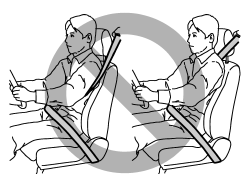Fastening the seatbelt
WARNING
● Never use a belt that is twisted or reversed. In an accident, this can increase the risk or severity of injury.
● Keep the lap belt as low as possible on your hips. In a collision, this spreads the force of the lap belt over stronger hip bones instead of across the weaker abdomen.
● Seatbelts provide maximum restraint when the occupant sits well back and upright in the seat. To reduce the risk of sliding under the seatbelt in a collision, the front seatbacks should be always used in the upright position while the vehicle is running. If the front seatbacks are not used in the upright position in a collision, the risk of sliding under the lap belt and of the lap belt sliding up over the abdomen will increase, and both can result in serious internal injury or death.
● Do not put cushions or any other materials between occupants and seatbacks or seat cushions. If you do so, the risk of sliding under the lap belt and of the lap belt sliding up over the abdomen will increase, and both can result in serious internal injury or death.

WARNING
Never place the shoulder belt under the arm or behind the back. If an accident occurs, this can increase the risk or severity of injury.
CAUTION
Metallic parts of the seatbelt can become very hot in a vehicle that has been closed up in sunny weather; they could burn an occupant. Do not touch such hot parts until they cool.
See also:
Moonroof (if equipped)
WARNING
Never let anyone’s hands, arms, head or any objects protrude from the moonroof.
A person could be seriously injured if the vehicle stops suddenly or turns sharply
or if the vehicle is inv ...
Center console
Center console
To open the lid, pull up the lock release. ...
Operating the driver’s window (type A)
Operating the driver’s window (type A)
1) Automatically open/close
2) Open/close
To open:
Push the switch down lightly and hold it.
The window will open as long as the switch is held.
This switc ...


